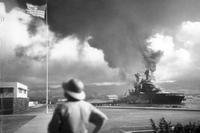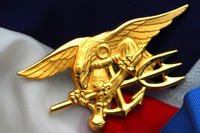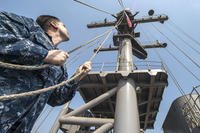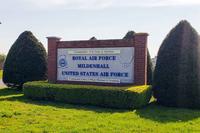Cmdr. Nate Christensen is the public affairs officer to the chief of naval operations. Lt. Cmdr. Mike Mabrey is the speechwriter to the CNO. Lt. Mary Sanford is the deputy PAO to the CNO.
While the U.S. Navy is accustomed to confronting those who seek to challenge established international norms and rules, we now face a new, invisible enemy, which attacks people from all walks of life indiscriminately and has no regard for collateral damage.
Indeed, COVID-19 has brought a fight to America's shores, and the Navy has been forced to confront a global pandemic, all while continuing to carry out its mission, day in and day out.
To be sure, times are both challenging and unprecedented right now, but that's never deterred the service before. And it will not this time either.
"As the forward-deployed force of our country, we have a duty to ensure we are ready to respond," Chief of Naval Operations Adm. Mike Gilday recently said in a message to the force. "We cannot simply take a knee or keep everyone in port until this enemy is defeated. We must be laser-focused on the Fleet -- from manning to maintenance, and from training to warfighting. Operational readiness is our job … and every one of us has a role. Nobody sits on the bench."
Today, the disruption caused by our new adversary -- COVID-19, combined with the potential for others to exploit this crisis for their own gain, makes protecting the seas more important than ever. That is why the Navy continues to operate forward as America's "away team," and why we will continue to do so for decades to come.
While some headlines of the past month may cause people to think COVID-19 has limited the Navy's ability to operate at sea, that couldn't be further from the truth. Today, our force remains ready, relevant and deployed forward around the globe.
For example, as of May 10, more than a third of the service's 299 ships, to include six aircraft carriers and four amphibious assault ships, were underway to help provide security and stability around the globe. Just two days prior, every one of the U.S. Pacific Fleet's forward-deployed submarines was at sea.
The Navy has also recently conducted several operations and exercises alongside our allies and partners. Over the past month, U.S. and British ships carried out an anti-submarine exercise above the Arctic Circle; four U.S. Navy ships and a Royal Navy ship conducted maritime security operations in the Barents Sea; and the USS Dwight D. Eisenhower Carrier Strike Group and French Navy conducted a bilateral exercise in the North Arabian Sea. We will continue to exercise at sea with partner nations, including during the 2020 Rim of the Pacific Exercise later this summer.
Adm. Jamie Foggo, commander of U.S. Naval Forces Europe-Africa, recently discussed how the Navy must be prepared to operate going forward in a "Proceedings" article entitled "Germs: The Seventh Domain of Warfare."
"Confronting a pandemic requires an all-hands approach. We must work with our interagency and host nation partners to leverage mutual strengths in order to effectively stem the spread of the virus, while offering our support to those in need," Foggo said. "Yet we must be mindful of our operational readiness, retaining the ability to respond immediately if challenged in another domain of warfare."
Along with operating together at sea, the CNO has remained in contact with his counterparts over the past several weeks, and members of the OPNAV staff have worked closely with other navies to share lessons and best practices in the fight against COVID-19.
A number of COVID-19 frameworks have been shared with our allies and partners, which help guide commanders in pre-deployment, mitigation and recovery practices against the virus. Additionally, the U.S. Naval COVID-19 Rapid Response Team has exchanged scientific and engineering data with other navies to advance understanding of the virus and its effects on ships and facilities. Many navies have also chosen to share their approaches on the All Partners Access Network website, to facilitate rapid responses within this network.
"Despite worldwide restrictions caused by COVID-19, we have found creative ways to work with our allies and partners, that has not only had positive operational impact, but also positions the U.S. Navy to conquer future unforeseen challenges, like this one," said Rear Adm. Will Pennington, the Navy's director of Global Integration and Engagement. "These robust exchanges with our allies and partners have dramatically steepened the collective learning curve within our vibrant and growing network of like-minded navies."
We have stood watch together throughout history; we fought our battles as allied forces; and this new fight is no different. The Navy is operating in every corner of the globe alongside our partners 24/7/365 because, now, more than ever, the world's prosperity and security depend on it.
In mid-April, Defense Secretary Mark Esper said during a town hall meeting at the Pentagon that, "Many of our adversaries ... are trying to exploit this crisis."
And they have certainly tried. In the span of four days in April, Russian pilots twice intercepted our P-8A Maritime Patrol and Reconnaissance Aircraft in an unsafe and unprofessional manner in the U.S. Sixth Fleet area of operations. Earlier that same month, 11 Iranian Islamic Revolutionary Guard Corps Navy vessels conducted dangerous and harassing approaches of U.S. naval forces inside the Arabian Gulf.
But that's not all.
Secretary of State Mike Pompeo recently highlighted how the Chinese Communist Party is asserting itself in the South China Sea while the world is focused on COVID-19.
"Beijing has moved to take advantage of the distraction, from China's new unilateral announcement of administrative districts over disputed islands and maritime areas in the South China Sea, its sinking of a Vietnamese fishing vessel earlier this month, and its 'research stations' on Fiery Cross Reef and Subi Reef," Pompeo said. "It is important to highlight how the Chinese Communist Party is exploiting the world's focus on the COVID-19 crisis by continuing its provocative behavior."
That is why the U.S. Navy, along with our allies and partners, continues to patrol critical waterways like the South China Sea during this pandemic to provide continued security and stability, which results in a free and open global maritime commons. By operating forward, we are where it matters, when it matters.
The Navy's ships need no permission to operate at sea. They are lethal, reliable and multi-dimensional. They are a formidable naval force that clearly and undeniably represents our nation's power by their mere presence. Their power does not rest in geographic location, but rather in their ability to maneuver freely while operating across the spectrum of military operations.
Today, the U.S. Navy, and our global team of like-minded navies, operate as the world's first line of defense against lawlessness and aggression, providing strength in unity that cannot be matched by any alternative.
To be sure, we are a force for good. But make no mistake, we are also a force to be reckoned with.
-- The opinions expressed in this op-ed are those of the author and do not necessarily reflect the views of Military.com. If you would like to submit your own commentary, please send your article to opinions@military.com for consideration.














